ESP Alfa Romeo 4C 2016 Owner handbook (in English)
[x] Cancel search | Manufacturer: ALFA ROMEO, Model Year: 2016, Model line: 4C, Model: Alfa Romeo 4C 2016Pages: 182, PDF Size: 9.49 MB
Page 75 of 182
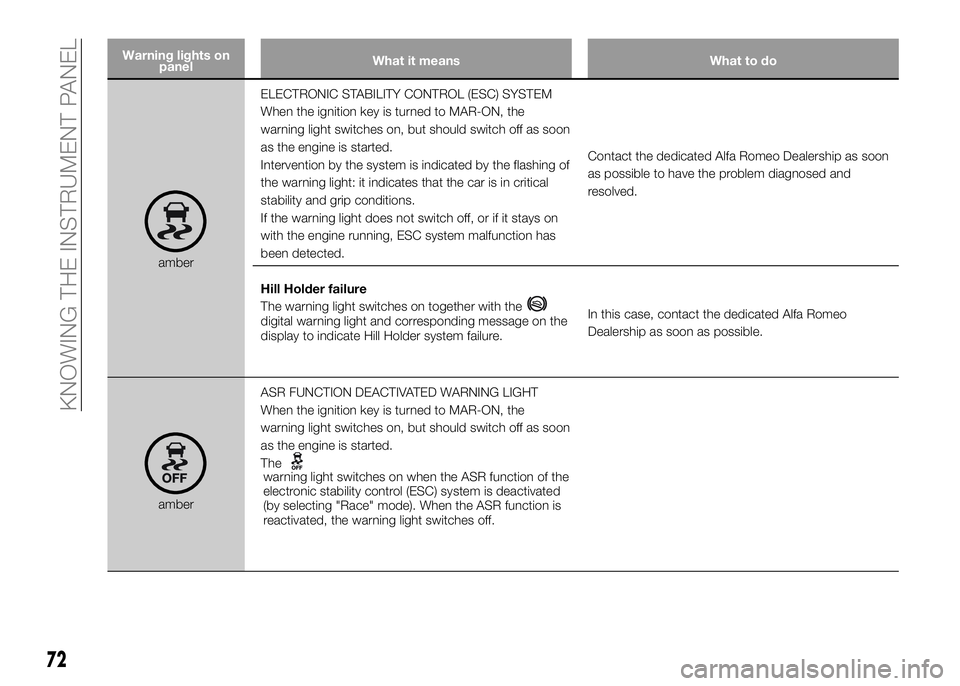
Warning lights on
panelWhat it means What to do
amberELECTRONIC STABILITY CONTROL (ESC) SYSTEM
When the ignition key is turned to MAR-ON, the
warning light switches on, but should switch off as soon
as the engine is started.
Intervention by the system is indicated by the flashing of
the warning light: it indicates that the car is in critical
stability and grip conditions.
If the warning light does not switch off, or if it stays on
with the engine running, ESC system malfunction has
been detected.Contact the dedicated Alfa Romeo Dealership as soon
as possible to have the problem diagnosed and
resolved.
Hill Holder failure
The warning light switches on together with the
digital warning light and corresponding message on the
display to indicate Hill Holder system failure.In this case, contact the dedicated Alfa Romeo
Dealership as soon as possible.
amberASR FUNCTION DEACTIVATED WARNING LIGHT
When the ignition key is turned to MAR-ON, the
warning light switches on, but should switch off as soon
as the engine is started.
The
warning light switches on when the ASR function of the
electronic stability control (ESC) system is deactivated
(by selecting "Race" mode). When the ASR function is
reactivated, the warning light switches off.
72
KNOWING THE INSTRUMENT PANEL
Page 82 of 182
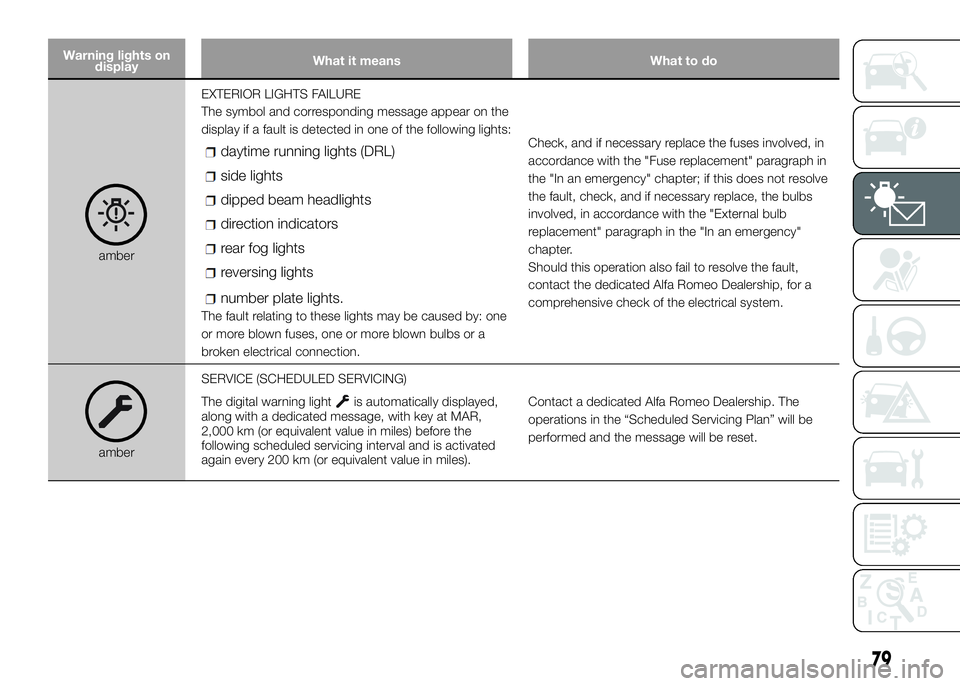
Warning lights on
displayWhat it means What to do
amberEXTERIOR LIGHTS FAILURE
The symbol and corresponding message appear on the
display if a fault is detected in one of the following lights:
daytime running lights (DRL)
side lights
dipped beam headlights
direction indicators
rear fog lights
reversing lights
number plate lights.
The fault relating to these lights may be caused by: one
or more blown fuses, one or more blown bulbs or a
broken electrical connection.Check, and if necessary replace the fuses involved, in
accordance with the "Fuse replacement" paragraph in
the "In an emergency" chapter; if this does not resolve
the fault, check, and if necessary replace, the bulbs
involved, in accordance with the "External bulb
replacement" paragraph in the "In an emergency"
chapter.
Should this operation also fail to resolve the fault,
contact the dedicated Alfa Romeo Dealership, for a
comprehensive check of the electrical system.
amberSERVICE (SCHEDULED SERVICING)
The digital warning light
is automatically displayed,
along with a dedicated message, with key at MAR,
2,000 km (or equivalent value in miles) before the
following scheduled servicing interval and is activated
again every 200 km (or equivalent value in miles).Contact a dedicated Alfa Romeo Dealership. The
operations in the “Scheduled Servicing Plan” will be
performed and the message will be reset.
79
Page 83 of 182
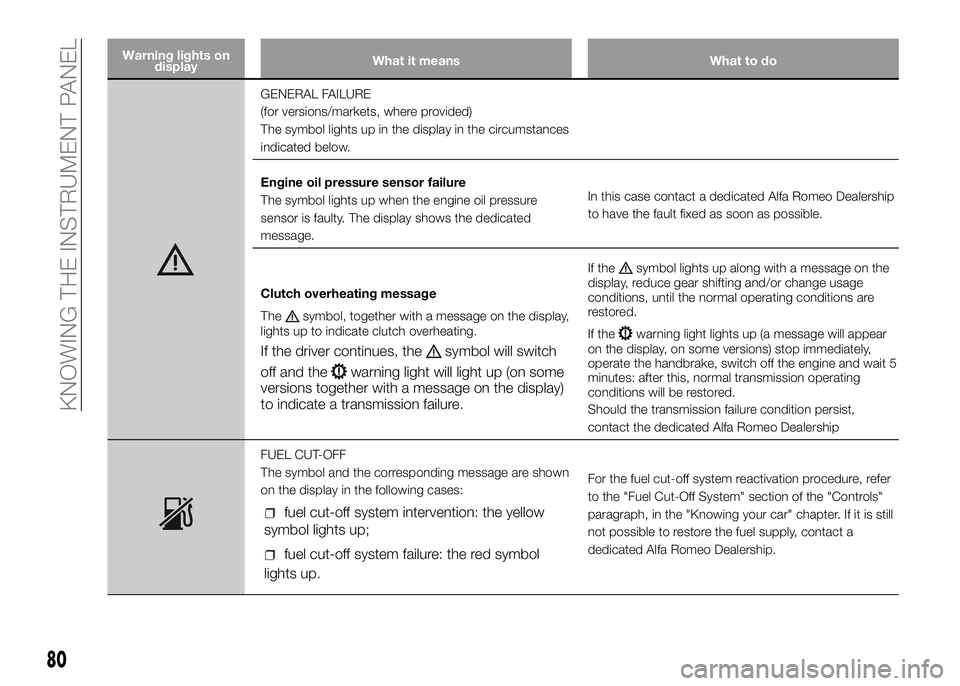
Warning lights on
displayWhat it means What to do
GENERAL FAILURE
(for versions/markets, where provided)
The symbol lights up in the display in the circumstances
indicated below.
Engine oil pressure sensor failure
The symbol lights up when the engine oil pressure
sensor is faulty. The display shows the dedicated
message.In this case contact a dedicated Alfa Romeo Dealership
to have the fault fixed as soon as possible.
Clutch overheating message
The
symbol, together with a message on the display,
lights up to indicate clutch overheating.
If the driver continues, thesymbol will switch
off and the
warning light will light up (on some
versions together with a message on the display)
to indicate a transmission failure.
If thesymbol lights up along with a message on the
display, reduce gear shifting and/or change usage
conditions, until the normal operating conditions are
restored.
If the
warning light lights up (a message will appear
on the display, on some versions) stop immediately,
operate the handbrake, switch off the engine and wait 5
minutes: after this, normal transmission operating
conditions will be restored.
Should the transmission failure condition persist,
contact the dedicated Alfa Romeo Dealership
FUEL CUT-OFF
The symbol and the corresponding message are shown
on the display in the following cases:
fuel cut-off system intervention: the yellow
symbol lights up;
fuel cut-off system failure: the red symbol
lights up.
For the fuel cut-off system reactivation procedure, refer
to the "Fuel Cut-Off System" section of the "Controls"
paragraph, in the "Knowing your car" chapter. If it is still
not possible to restore the fuel supply, contact a
dedicated Alfa Romeo Dealership.
80
KNOWING THE INSTRUMENT PANEL
Page 84 of 182
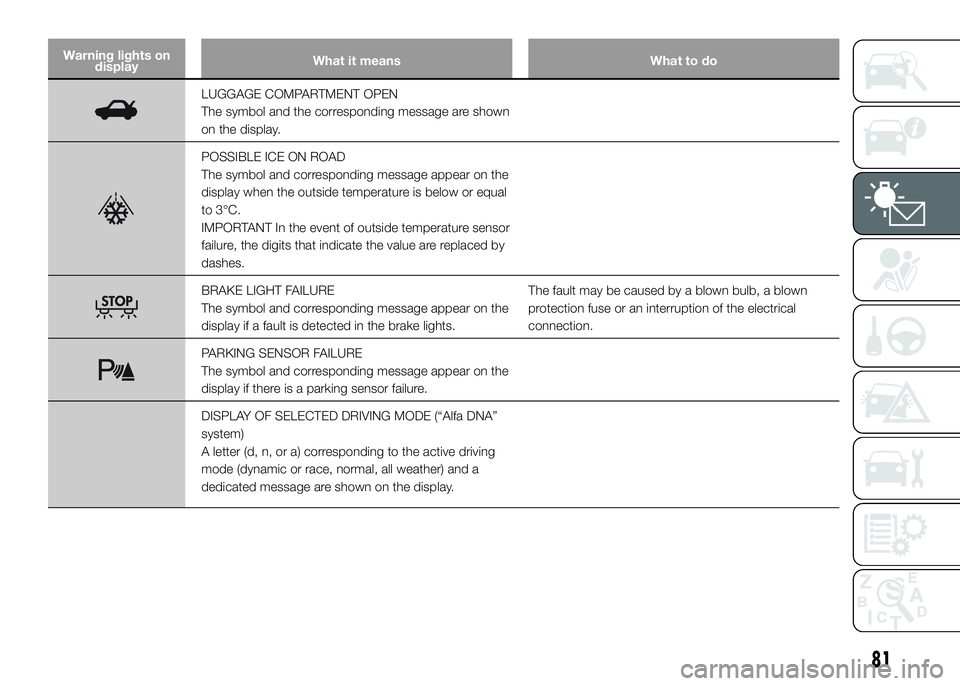
Warning lights on
displayWhat it means What to do
LUGGAGE COMPARTMENT OPEN
The symbol and the corresponding message are shown
on the display.
POSSIBLE ICE ON ROAD
The symbol and corresponding message appear on the
display when the outside temperature is below or equal
to 3°C.
IMPORTANT In the event of outside temperature sensor
failure, the digits that indicate the value are replaced by
dashes.
BRAKE LIGHT FAILURE
The symbol and corresponding message appear on the
display if a fault is detected in the brake lights.The fault may be caused by a blown bulb, a blown
protection fuse or an interruption of the electrical
connection.
PARKING SENSOR FAILURE
The symbol and corresponding message appear on the
display if there is a parking sensor failure.
DISPLAY OF SELECTED DRIVING MODE (“Alfa DNA”
system)
A letter (d, n, or a) corresponding to the active driving
mode (dynamic or race, normal, all weather) and a
dedicated message are shown on the display.
81
Page 90 of 182
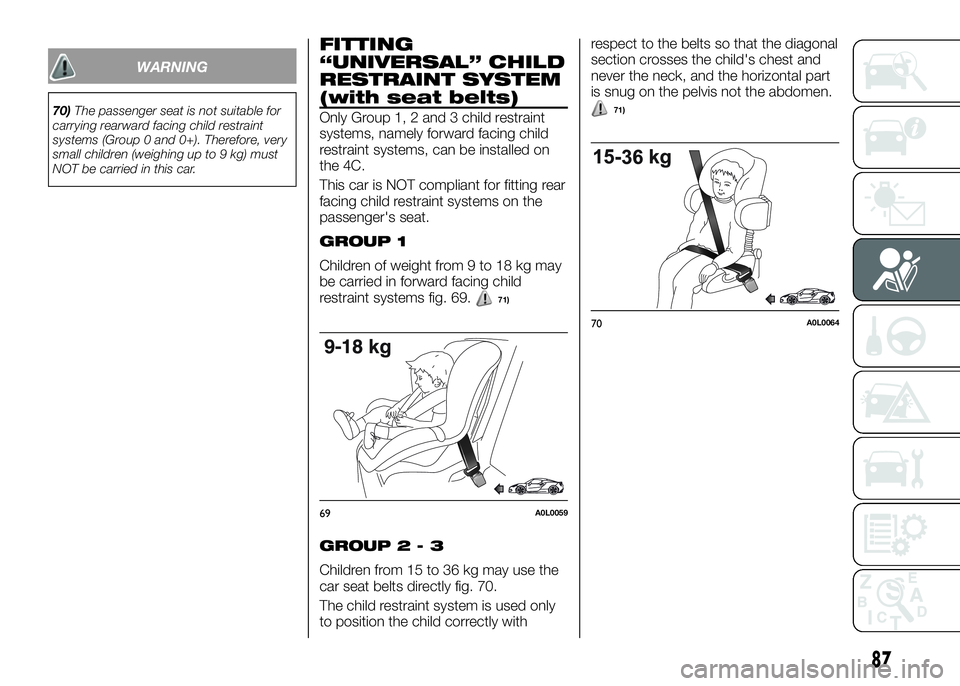
WARNING
70)The passenger seat is not suitable for
carrying rearward facing child restraint
systems (Group 0 and 0+). Therefore, very
small children (weighing up to 9 kg) must
NOT be carried in this car.
FITTING
“UNIVERSAL” CHILD
RESTRAINT SYSTEM
(with seat belts)
Only Group 1, 2 and 3 child restraint
systems, namely forward facing child
restraint systems, can be installed on
the 4C.
This car is NOT compliant for fitting rear
facing child restraint systems on the
passenger's seat.
GROUP 1
Children of weight from 9 to 18 kg may
be carried in forward facing child
restraint systems fig. 69.
71)
GROUP2-3
Children from 15 to 36 kg may use the
car seat belts directly fig. 70.
The child restraint system is used only
to position the child correctly withrespect to the belts so that the diagonal
section crosses the child's chest and
never the neck, and the horizontal part
is snug on the pelvis not the abdomen.
71)
69A0L0059
70A0L0064
87
Page 93 of 182
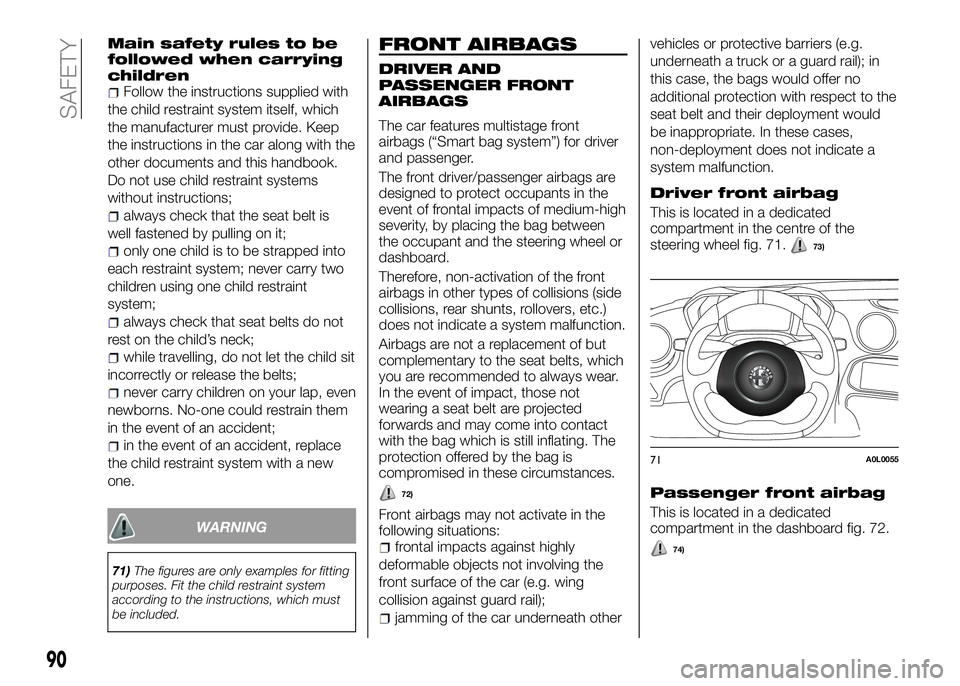
Main safety rules to be
followed when carrying
children
Follow the instructions supplied with
the child restraint system itself, which
the manufacturer must provide. Keep
the instructions in the car along with the
other documents and this handbook.
Do not use child restraint systems
without instructions;
always check that the seat belt is
well fastened by pulling on it;
only one child is to be strapped into
each restraint system; never carry two
children using one child restraint
system;
always check that seat belts do not
rest on the child’s neck;
while travelling, do not let the child sit
incorrectly or release the belts;
never carry children on your lap, even
newborns. No-one could restrain them
in the event of an accident;
in the event of an accident, replace
the child restraint system with a new
one.
WARNING
71)The figures are only examples for fitting
purposes. Fit the child restraint system
according to the instructions, which must
be included.
FRONT AIRBAGS
DRIVER AND
PASSENGER FRONT
AIRBAGS
The car features multistage front
airbags (“Smart bag system”) for driver
and passenger.
The front driver/passenger airbags are
designed to protect occupants in the
event of frontal impacts of medium-high
severity, by placing the bag between
the occupant and the steering wheel or
dashboard.
Therefore, non-activation of the front
airbags in other types of collisions (side
collisions, rear shunts, rollovers, etc.)
does not indicate a system malfunction.
Airbags are not a replacement of but
complementary to the seat belts, which
you are recommended to always wear.
In the event of impact, those not
wearing a seat belt are projected
forwards and may come into contact
with the bag which is still inflating. The
protection offered by the bag is
compromised in these circumstances.
72)
Front airbags may not activate in the
following situations:
frontal impacts against highly
deformable objects not involving the
front surface of the car (e.g. wing
collision against guard rail);
jamming of the car underneath othervehicles or protective barriers (e.g.
underneath a truck or a guard rail); in
this case, the bags would offer no
additional protection with respect to the
seat belt and their deployment would
be inappropriate. In these cases,
non-deployment does not indicate a
system malfunction.
Driver front airbag
This is located in a dedicated
compartment in the centre of the
steering wheel fig. 71.
73)
Passenger front airbag
This is located in a dedicated
compartment in the dashboard fig. 72.
74)
71A0L0055
90
SAFETY
Page 98 of 182
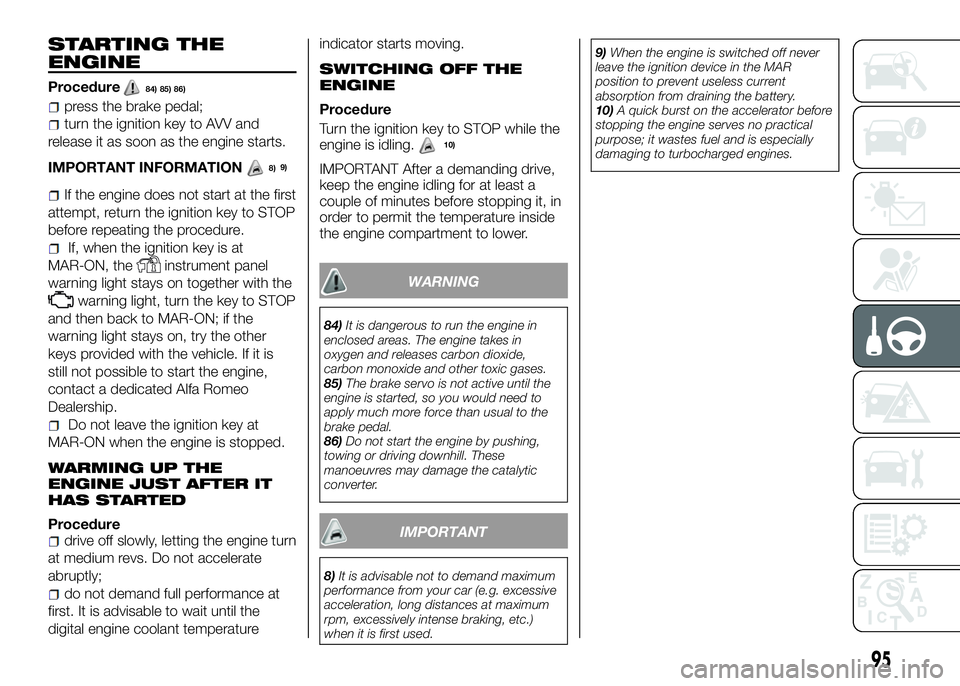
STARTING THE
ENGINE
Procedure84) 85) 86)
press the brake pedal;
turn the ignition key to AVV and
release it as soon as the engine starts.
IMPORTANT INFORMATION
9)
If the engine does not start at the first
attempt, return the ignition key to STOP
before repeating the procedure.
If, when the ignition key is at
MAR-ON, the
instrument panel
warning light stays on together with the
warning light, turn the key to STOP
and then back to MAR-ON; if the
warning light stays on, try the other
keys provided with the vehicle. If it is
still not possible to start the engine,
contact a dedicated Alfa Romeo
Dealership.
Do not leave the ignition key at
MAR-ON when the engine is stopped.
WARMING UP THE
ENGINE JUST AFTER IT
HAS STARTED
Proceduredrive off slowly, letting the engine turn
at medium revs. Do not accelerate
abruptly;
do not demand full performance at
first. It is advisable to wait until the
digital engine coolant temperatureindicator starts moving.
SWITCHING OFF THE
ENGINE
Procedure
Turn the ignition key to STOP while the
engine is idling.
IMPORTANT After a demanding drive,
keep the engine idling for at least a
couple of minutes before stopping it, in
order to permit the temperature inside
the engine compartment to lower.
WARNING
84)It is dangerous to run the engine in
enclosed areas. The engine takes in
oxygen and releases carbon dioxide,
carbon monoxide and other toxic gases.
85)The brake servo is not active until the
engine is started, so you would need to
apply much more force than usual to the
brake pedal.
86)Do not start the engine by pushing,
towing or driving downhill. These
manoeuvres may damage the catalytic
converter.
IMPORTANT
8)It is advisable not to demand maximum
performance from your car (e.g. excessive
acceleration, long distances at maximum
rpm, excessively intense braking, etc.)
when it is first used.9)When the engine is switched off never
leave the ignition device in the MAR
position to prevent useless current
absorption from draining the battery.
10)A quick burst on the accelerator before
stopping the engine serves no practical
purpose; it wastes fuel and is especially
damaging to turbocharged engines.
95
8)10)
Page 99 of 182
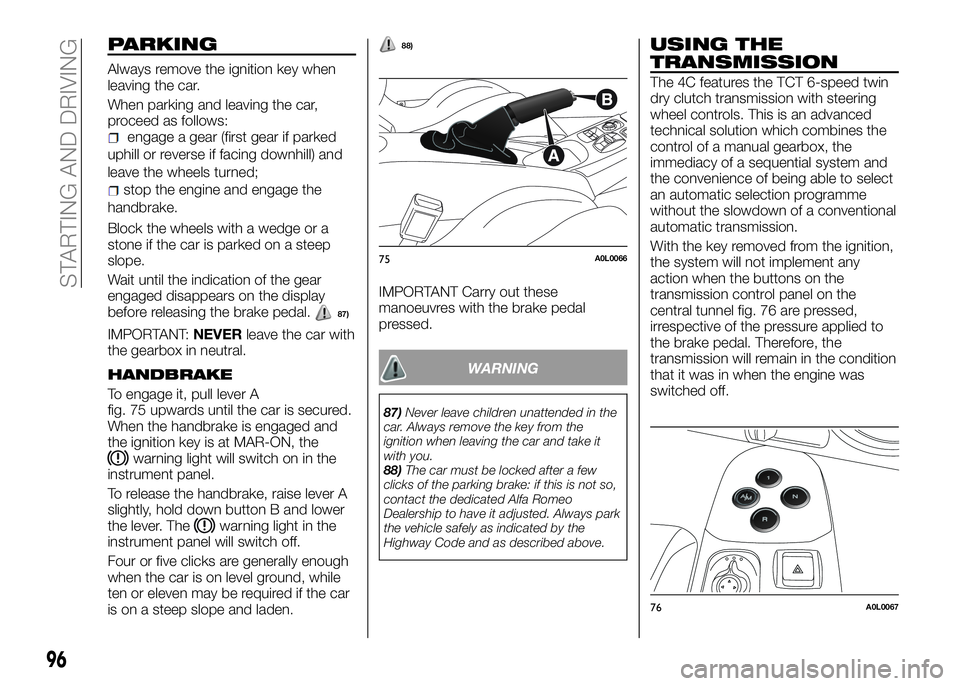
PARKING
Always remove the ignition key when
leaving the car.
When parking and leaving the car,
proceed as follows:
engage a gear (first gear if parked
uphill or reverse if facing downhill) and
leave the wheels turned;
stop the engine and engage the
handbrake.
Block the wheels with a wedge or a
stone if the car is parked on a steep
slope.
Wait until the indication of the gear
engaged disappears on the display
before releasing the brake pedal.
87)
IMPORTANT:NEVERleave the car with
the gearbox in neutral.
HANDBRAKE
To engage it, pull lever A
fig. 75 upwards until the car is secured.
When the handbrake is engaged and
the ignition key is at MAR-ON, the
warning light will switch on in the
instrument panel.
To release the handbrake, raise lever A
slightly, hold down button B and lower
the lever. The
warning light in the
instrument panel will switch off.
Four or five clicks are generally enough
when the car is on level ground, while
ten or eleven may be required if the car
is on a steep slope and laden.
88)
IMPORTANT Carry out these
manoeuvres with the brake pedal
pressed.
WARNING
87)Never leave children unattended in the
car. Always remove the key from the
ignition when leaving the car and take it
with you.
88)The car must be locked after a few
clicks of the parking brake: if this is not so,
contact the dedicated Alfa Romeo
Dealership to have it adjusted. Always park
the vehicle safely as indicated by the
Highway Code and as described above.
USING THE
TRANSMISSION
The 4C features the TCT 6-speed twin
dry clutch transmission with steering
wheel controls. This is an advanced
technical solution which combines the
control of a manual gearbox, the
immediacy of a sequential system and
the convenience of being able to select
an automatic selection programme
without the slowdown of a conventional
automatic transmission.
With the key removed from the ignition,
the system will not implement any
action when the buttons on the
transmission control panel on the
central tunnel fig. 76 are pressed,
irrespective of the pressure applied to
the brake pedal. Therefore, the
transmission will remain in the condition
that it was in when the engine was
switched off.
75A0L0066
76A0L0067
96
STARTING AND DRIVING
Page 100 of 182
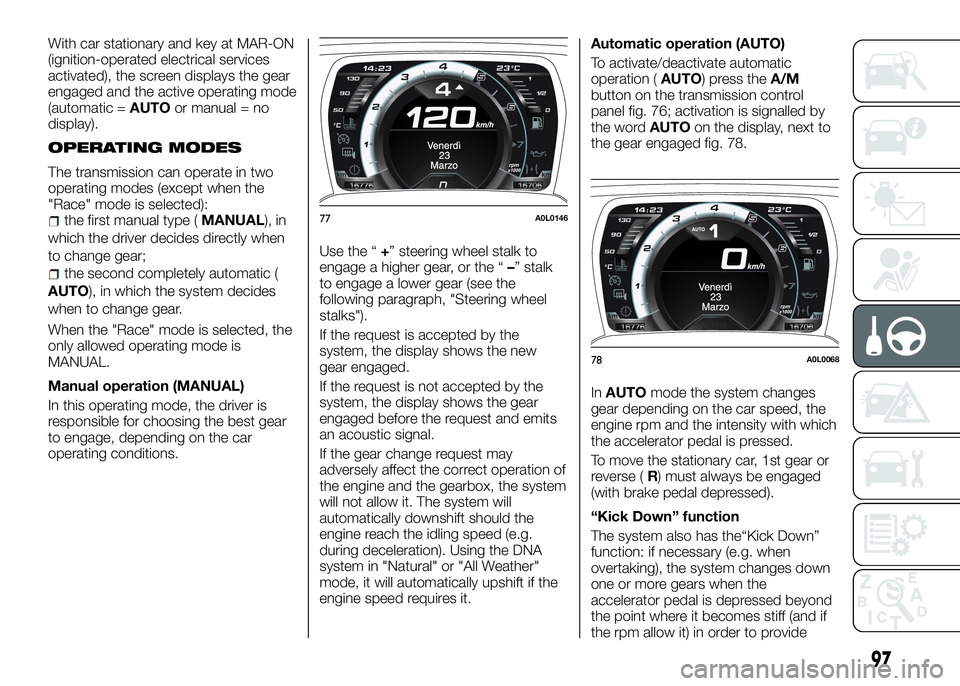
With car stationary and key at MAR-ON
(ignition-operated electrical services
activated), the screen displays the gear
engaged and the active operating mode
(automatic =AUTOor manual = no
display).
OPERATING MODES
The transmission can operate in two
operating modes (except when the
"Race" mode is selected):
the first manual type (MANUAL), in
which the driver decides directly when
to change gear;
the second completely automatic (
AUTO), in which the system decides
when to change gear.
When the "Race" mode is selected, the
only allowed operating mode is
MANUAL.
Manual operation (MANUAL)
In this operating mode, the driver is
responsible for choosing the best gear
to engage, depending on the car
operating conditions.Use the “+” steering wheel stalk to
engage a higher gear, or the “–” stalk
to engage a lower gear (see the
following paragraph, "Steering wheel
stalks").
If the request is accepted by the
system, the display shows the new
gear engaged.
If the request is not accepted by the
system, the display shows the gear
engaged before the request and emits
an acoustic signal.
If the gear change request may
adversely affect the correct operation of
the engine and the gearbox, the system
will not allow it. The system will
automatically downshift should the
engine reach the idling speed (e.g.
during deceleration). Using the DNA
system in "Natural" or "All Weather"
mode, it will automatically upshift if the
engine speed requires it.Automatic operation (AUTO)
To activate/deactivate automatic
operation (AUTO) press theA/M
button on the transmission control
panel fig. 76; activation is signalled by
the wordAUTOon the display, next to
the gear engaged fig. 78.
InAUTOmode the system changes
gear depending on the car speed, the
engine rpm and the intensity with which
the accelerator pedal is pressed.
To move the stationary car, 1st gear or
reverse (R) must always be engaged
(with brake pedal depressed).
“Kick Down” function
The system also has the“Kick Down”
function: if necessary (e.g. when
overtaking), the system changes down
one or more gears when the
accelerator pedal is depressed beyond
the point where it becomes stiff (and if
the rpm allow it) in order to provide
77A0L0146
78A0L0068
97
Page 101 of 182
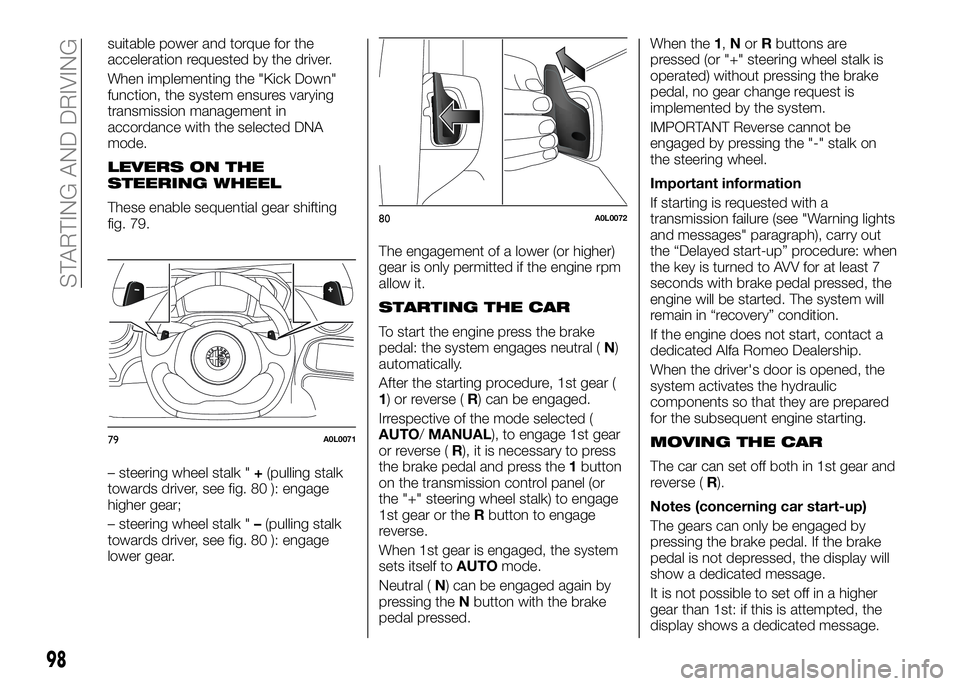
suitable power and torque for the
acceleration requested by the driver.
When implementing the "Kick Down"
function, the system ensures varying
transmission management in
accordance with the selected DNA
mode.
LEVERS ON THE
STEERING WHEEL
These enable sequential gear shifting
fig. 79.
– steering wheel stalk "+(pulling stalk
towards driver, see fig. 80 ): engage
higher gear;
– steering wheel stalk "–(pulling stalk
towards driver, see fig. 80 ): engage
lower gear.The engagement of a lower (or higher)
gear is only permitted if the engine rpm
allow it.
STARTING THE CAR
To start the engine press the brake
pedal: the system engages neutral (N)
automatically.
After the starting procedure, 1st gear (
1) or reverse (R) can be engaged.
Irrespective of the mode selected (
AUTO/MANUAL), to engage 1st gear
or reverse (R), it is necessary to press
the brake pedal and press the1button
on the transmission control panel (or
the "+" steering wheel stalk) to engage
1st gear or theRbutton to engage
reverse.
When 1st gear is engaged, the system
sets itself toAUTOmode.
Neutral (N) can be engaged again by
pressing theNbutton with the brake
pedal pressed.When the1,NorRbuttons are
pressed (or "+" steering wheel stalk is
operated) without pressing the brake
pedal, no gear change request is
implemented by the system.
IMPORTANT Reverse cannot be
engaged by pressing the "-" stalk on
the steering wheel.
Important information
If starting is requested with a
transmission failure (see "Warning lights
and messages" paragraph), carry out
the “Delayed start-up” procedure: when
the key is turned to AVV for at least 7
seconds with brake pedal pressed, the
engine will be started. The system will
remain in “recovery” condition.
If the engine does not start, contact a
dedicated Alfa Romeo Dealership.
When the driver's door is opened, the
system activates the hydraulic
components so that they are prepared
for the subsequent engine starting.
MOVING THE CAR
The car can set off both in 1st gear and
reverse (R).
Notes (concerning car start-up)
The gears can only be engaged by
pressing the brake pedal. If the brake
pedal is not depressed, the display will
show a dedicated message.
It is not possible to set off in a higher
gear than 1st: if this is attempted, the
display shows a dedicated message.
79A0L0071
80A0L0072
98
STARTING AND DRIVING